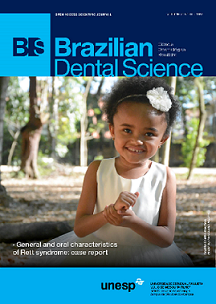Prevalence of Candida albicans and Streptococcus aureus on maxillary obturators, maxillary defects and in saliva: A cross-sectional study
DOI:
https://doi.org/10.14295/bds.2017.v20i3.1366Abstract
Objective: This study investigated on the incidence of Candida albicans and Staphylococcus aureus adhesion onto maxillary obturator prostheses with soft lining materials placed by prosthodontists. Material and Methods: Between years 2013 and 2014, patients with maxillary defects due to maxillary tumor surgery and acquired obturator prostheses (n = 21, study group) were clinically evaluated and microbiological outcomes were compared with complete maxillary denture wearers (n = 21, control group). Data were collected on demographic features, histological type of cancer, presence of chemotherapy or radiotherapy, identification of soft lining materials used on obturator prostheses, cleansing methods practiced for obturator and maxillary complete prostheses. The presence of Candida albicans was determined on soft lining materials or polymethylmethacrylate surfaces and in the oral cavity, and Staphylococcus aureus in nasal mucosa and saliva. Data were analyzed using Kruskal Wallis, Fisher-Freeman-Halton tests (p < 0.05). Results: The highest amount of Candida albicans was found on surfaces of prostheses, in the saliva and on maxillary defects on the hard palate and on definitive soft lining material with 90%, 90%, and 70%, respectively. The highest amount of Staphylococcus aureus was observed in the saliva and nasal cavity in the definitive soft lining material group (50%). Conclusion: Short renewal period of lining materials may cause less Candida albicans colonisation and denture stomatitis in the oral cavity. Patients who have undergone maxillectomy were more prone to Staphylococcus aureus colonisation.
Keywords
Candida albicans; Denture liners; Maxillary prosthesis; Palatal obturators; Staphylococcus aureus.
Downloads
Downloads
Additional Files
Published
How to Cite
Issue
Section
License
Brazilian Dental Science uses the Creative Commons (CC-BY 4.0) license, thus preserving the integrity of articles in an open access environment. The journal allows the author to retain publishing rights without restrictions.
=================




























